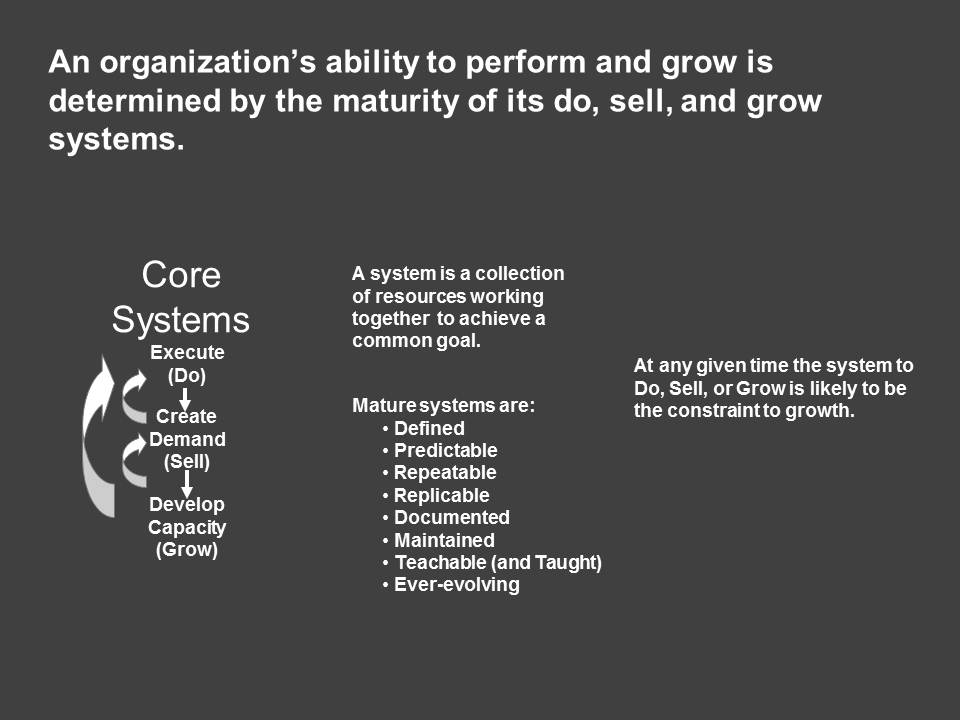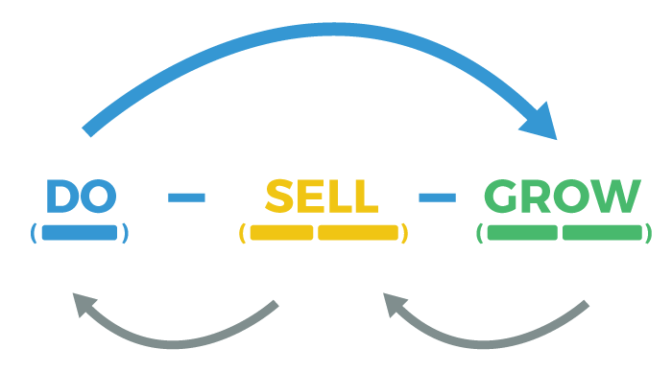Imagine:
- An organization that does not know how it will meet the demands of its current customers, or
- An organization that has no idea where its next customer will come from, or
- An organization that does not know how it will acquire resources needed to meet a surge in demand.
Such organizations exist and they are stuck. That is, their ability to perform and grow is severely constrained.
Organizations that experience sustained growth and high performance execute, create demand, and develop capacity in orderly, or systematic, ways. A system is a collection of resources working together to accomplish a common goal. The resources of an organization aggregate into three essential systems:
- The Execution System, or what the organization does to Do what it does.
- The Demand Creation System, or what the organization does to Sell what it does, including marketing, lead generation, sales, sales engineering, proposal writing, and sales support.
- The Capacity Development System, or what the organization does to Grow, including training, recruiting, fund raising, performance assessment, goal setting, systems development, and process engineering.
Anything an organization does other than Do, Sell, or Grow, and that makes sense to continue doing, should be to facilitate, improve, or otherwise efficiently support its ability to Do, Sell, and Grow.
An organization that has execution problems essentially has no other problems because there is no point to growing or to landing new customers if the organization cannot even Do what it does to reliably deliver to customers it already has. Without a way to capture, organize, and distribute its collective knowledge from serving customers, an organization may have just a collection of unconnected experiences such that every new customer may be a “whole new adventure”. An organization that does not know for certain how it will meet delivery obligations runs serious risks and will find it difficult, if not impossible, to maintain control over the quality of its products and services.
Once there is a reliable way to execute, there is confidence to generate demand. However, without a way to generate demand that is predictable, repeatable, replicable, documented, maintained, taught, and ever-evolving, the organization’s ability to Do and Grow is likely to be constrained by its ability to Sell.
When new sales cause demand to exceed delivery capacity, it must Grow capacity to deliver. When capacity to deliver exceeds demand, it must Grow sales capacity. A growing organization needs to be clear about how it will add capacity to Do and how it will add capacity to Sell. For many organizations, this means identifying and cultivating sources of people, recruiting, and professional development.
At any time an organization’s ability to perform and grow tends to be constrained by one of the three core systems. Leadership’s job is to decide which system needs to evolve next and how.
For example, if a product provider generates more demand than can be handled by existing operations, then more production capacity is required. Once production capacity is in place, sales capacity may need to expand in order to put the increased production capacity to work. However, the amount of sales capacity should likely need to increase at a much slower rate than the rate of delivery capacity because a little more selling capacity should drive the need for a lot more delivery capacity.
In this sense, then, the evolution of Do, Sell, and Grow systems is iterative and staggered with execution capacity out in front of demand creation which is out in front of capacity to grow.
The larger and more complex an organization is, the more important it is for it to Do, Sell, and Grow in ways that are characteristic of more mature systems(see prior post on How growing organizations should go about evolving systems and processes); that is they need to be more:
- defined,
- predictable,
- repeatable,
- replicable,
- documented,
- maintained,
- taught, and
- revised to reflect lessons learned from experience.

As summarized in Figure 1:
- Organizations have three core systems to Do, Sell, and Grow what they do.
- At any time one of the three core systems is likely constraining growth.
- Leadership’s job is to determine which system is constraining growth and to develop that system to the point where it is no longer the constraint.
- As an organization grows in size and/or complexity it is important for their Do, Sell, and Grow systems to mature.
See also: ISO 9000 (https://www.iso.org/iso/iso_9000/), Baldridge award program (https://www.nist.gov/baldrige/), CMMi (https://www.sei.cmu.edu/cmmi/), and other programs that encourage and help organization to improve the maturity of their systems and processes.

